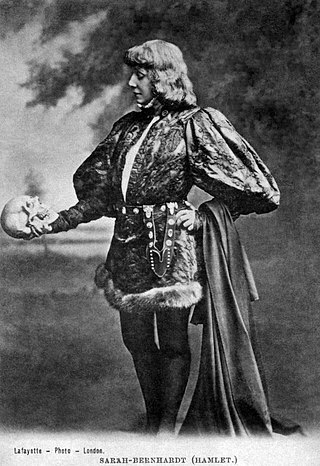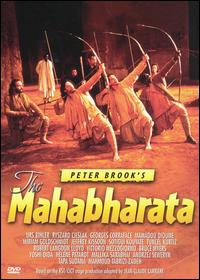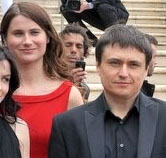Related Research Articles

Acting is an activity in which a story is told by means of its enactment by an actor or actress who adopts a character—in theatre, television, film, radio, or any other medium that makes use of the mimetic mode.

The performing arts are arts such as music, dance, and drama which are performed for an audience. They are different from the visual arts, which are the use of paint, canvas or various materials to create physical or static art objects. Performing arts include a range of disciplines which are performed in front of a live audience, including theatre, music, and dance.

Jerzy Marian Grotowski was a Polish theatre director and theorist whose innovative approaches to acting, training and theatrical production have significantly influenced theatre today.

Peter Stephen Paul Brook was an English theatre and film director. He worked first in England, from 1945 at the Birmingham Repertory Theatre, from 1947 at the Royal Opera House, and from 1962 for the Royal Shakespeare Company (RSC). With them, he directed the first English-language production in 1964 of Marat/Sade by Peter Weiss, which was transferred to Broadway in 1965 and won the Tony Award for Best Play, and Brook was named Best Director. He also directed films such as an iconic version of Lord of the Flies in 1963.
Cross-cultural communication is a field of study that looks at how people from differing cultural backgrounds communicate, in similar and different ways among themselves, and how they endeavor to communicate across cultures. Intercultural communication is a related field of study.

An intermission, also known as an interval in British and Indian English, is a recess between parts of a performance or production, such as for a theatrical play, opera, concert, or film screening. It should not be confused with an entr'acte, which, in the 18th century, was a sung, danced, spoken, or musical performance that occurs between any two acts, that is unrelated to the main performance, and that thus in the world of opera and musical theater became an orchestral performance that spans an intermission and leads, without a break, into the next act.

Experimental theatre, inspired largely by Wagner's concept of Gesamtkunstwerk, began in Western theatre in the late 19th century with Alfred Jarry and his Ubu plays as a rejection of both the age in particular and, in general, the dominant ways of writing and producing plays. The term has shifted over time as the mainstream theatre world has adopted many forms that were once considered radical.
Performance studies is an interdisciplinary academic field that uses performance as a lens and a tool to study the world. The term performance is broad, and can include artistic and aesthetic performances like concerts, theatrical events, and performance art; sporting events; social, political and religious events like rituals, ceremonies, proclamations and public decisions; certain kinds of language use; and those components of identity which require someone to do, rather than just be, something. Performance studies draws from theories and methods of the performing arts, anthropology, sociology, literary theory, culture studies, communication, and others.
Cross-cultural may refer to

The Mahabharata is a 1989 film version of the Hindu epic Mahabharata directed by Peter Brook. Brook's original 1985 stage play was 9 hours long, and toured around the world for four years. In 1989, it was reduced to under 6 hours for television. Later it was also reduced to about 3 hours for theatrical and DVD release. The screenplay was the result of eight years' work by Peter Brook, Jean-Claude Carrière and Marie-Hélène Estienne.

The Hong Kong Arts Festival (HKAF), launched in 1973, is a major international arts festival committed to enriching the cultural life of the city by presenting leading local and international artists in all genres of the performing arts as well as a diverse range of “PLUS” and educational events in February and March each year.

Ramlila (Rāmlīlā) is any dramatic folk re-enactment of the life of Rama according to the ancient Hindu epic Ramayana or secondary literature based on it such as the Ramcharitmanas. It particularly refers to the thousands of Hindu god Rama-related dramatic plays and dance events, that are staged during the annual autumn festival of Navratri in India. After the enactment of the legendary war between Good and Evil, the Ramlila celebrations climax in the Dussehra night festivities where the giant grotesque effigies of Evil such as of demon Ravana are burnt, typically with fireworks.

Theatre or theater is a collaborative form of performing art that uses live performers, usually actors or actresses, to present the experience of a real or imagined event before a live audience in a specific place, often a stage. The performers may communicate this experience to the audience through combinations of gesture, speech, song, music, and dance. Elements of art, such as painted scenery and stagecraft such as lighting are used to enhance the physicality, presence and immediacy of the experience. The specific place of the performance is also named by the word "theatre" as derived from the Ancient Greek θέατρον, itself from θεάομαι.
Rangimoana Taylor is an actor, theatre director, storyteller from New Zealand with more than 35 years in the industry. He has performed nationally and internationally and was the lead in the feature film Hook Line and Sinker (2011). He was an intrinsic part of three Māori theatre companies, Te Ohu Whakaari and Taki Rua in Wellington and Kilimogo Productions in Dunedin.
Patrice Pavis was Professor for Theatre Studies at the University of Kent in Canterbury, England (UK), where he retired at the end of the academic year 2015/16. He has written extensively about performance, focusing his study and research mainly in semiology and interculturalism in theatre. He was awarded the Georges Jamati Prize in 1986.

Cristina Flutur is a Romanian film and theatre actress.
The Mahabharata is a French play, based on the Sanskrit epic Mahābhārata, by Jean-Claude Carrière, which was first staged in a quarry just outside Avignon in a production by the English director Peter Brook. The play, which is nine hours long in performance, toured the world for four years. For two years the show was performed both in French and in English. The play is divided into three parts: The Game of Dice, The Exile in the Forest and The War. In 1989, it was adapted for television as a six-hour mini series. Later, it was reduced to about three hours as a film for theatrical and DVD release. The screenplay was the result of eight years' work by Peter Brook, Jean-Claude Carrière, and Marie-Hélène Estienne.

Magnet Theatre is an independent physical theatre company based in Cape Town, South Africa. It was formed in 1987 by Mark Fleishman and Jennie Reznek who have since been the company's artistic directors. Besides creating original theatre productions, Magnet Theatre is actively engaged in youth development work in the Cape Town area as well as in the Cederberg Municipality.
Carol Fischer Sorgenfrei is a scholar, translator, editor, and playwright who assumes the title of "founding mother" of Asian theater studies for her contributions to the study of cross-cultural performance and her expertise in Asian theatre. She has published extensively on Asian cultural practices and has written plays incorporating elements of traditional Japanese drama. Currently Professor Emeritus at UCLA, Sorgenfrei continues her creative work as a playwright.
Peter Michael Boenisch is a German theatre researcher. Since 2019, he had been Professor for Dramaturgy at Aarhus University (Denmark). In 2019, he was elected into the Academia Europaea.
References
- ↑ "By means of Performance"
- ↑ "Cross-cultural Theatre, Patrice Pavis"
- ↑ "Theatre world performance politics culture"
- ↑ "Metamorphoses"
- ↑ "SUSI Grants"
- ↑ "Performing Arts Institute"
- ↑ "The Global Theatre Project"
- ↑ "Kari Kinnunen"
- ↑ "John Martin Intercultural Performance"
- ↑ "Min Tian"
- ↑ "Rustom Bharucha"